All Posts > Fruiting Plants > Perennials > Plant Profiles
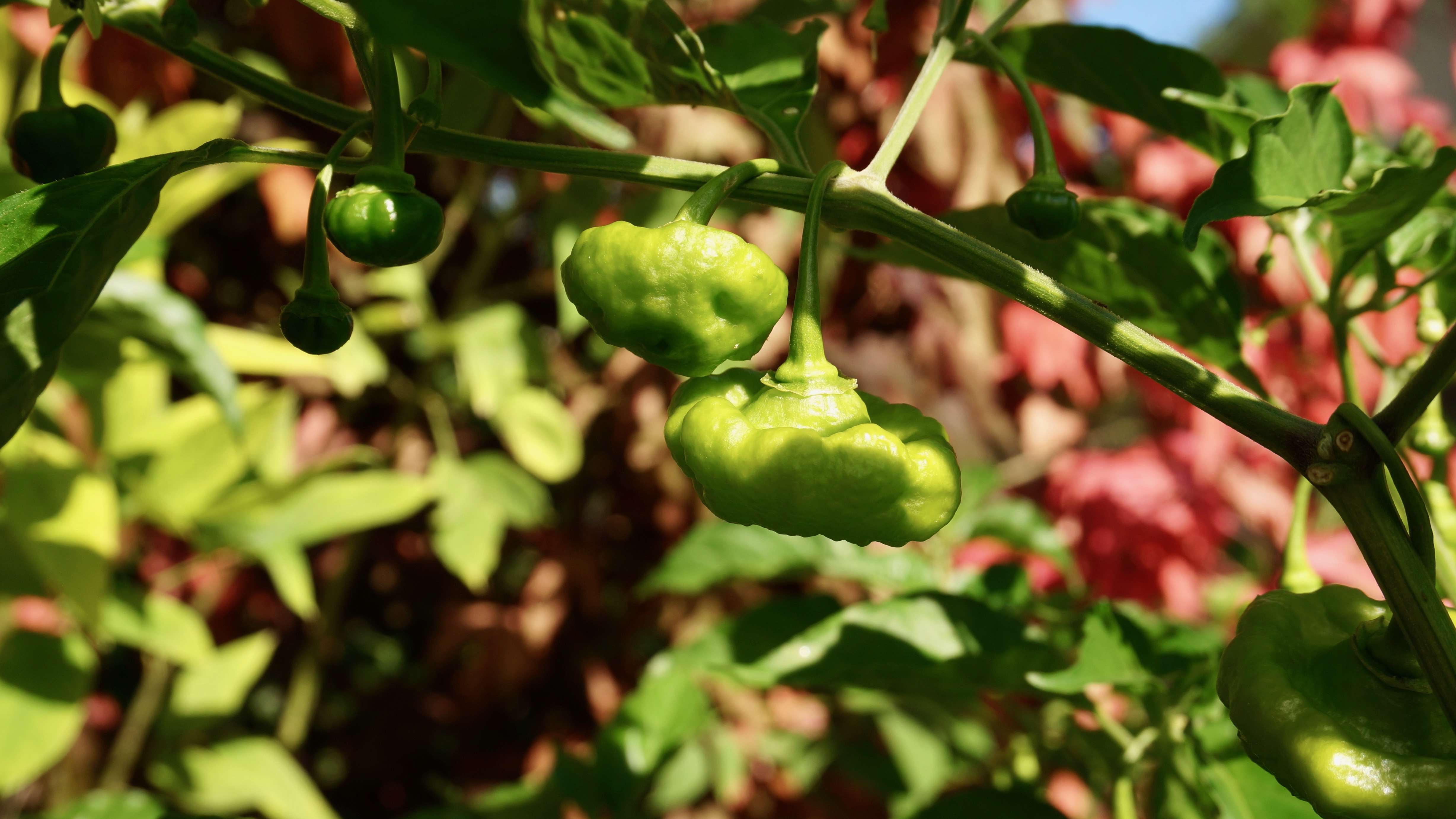
Introducing the Ají Cachucha
The ají cachucha is any small and perennial sweet chili pepper. In some areas, the name refers to a specific variety of sweet chili pepper. The variety I am growing is most commonly called ají cachucha in Cuba. In other regions it is known as ají dulce or ajicito. Besides Cuba, the variety I have is also traditionally grown in Puerto Rico and the Dominican Republic. The large immigrant population in the U.S. from these Caribbean islands has caused an increase in demand for sweet chili peppers in the U.S. Due to this, some U.S. farms now grow it; and it is often sold in latin grocery stores. There are many varieties in the Capsicum chinense species. For the purpose of this plant profile, I will be using ají cachucha to refer to the red variety I am growing and very similar varieties.
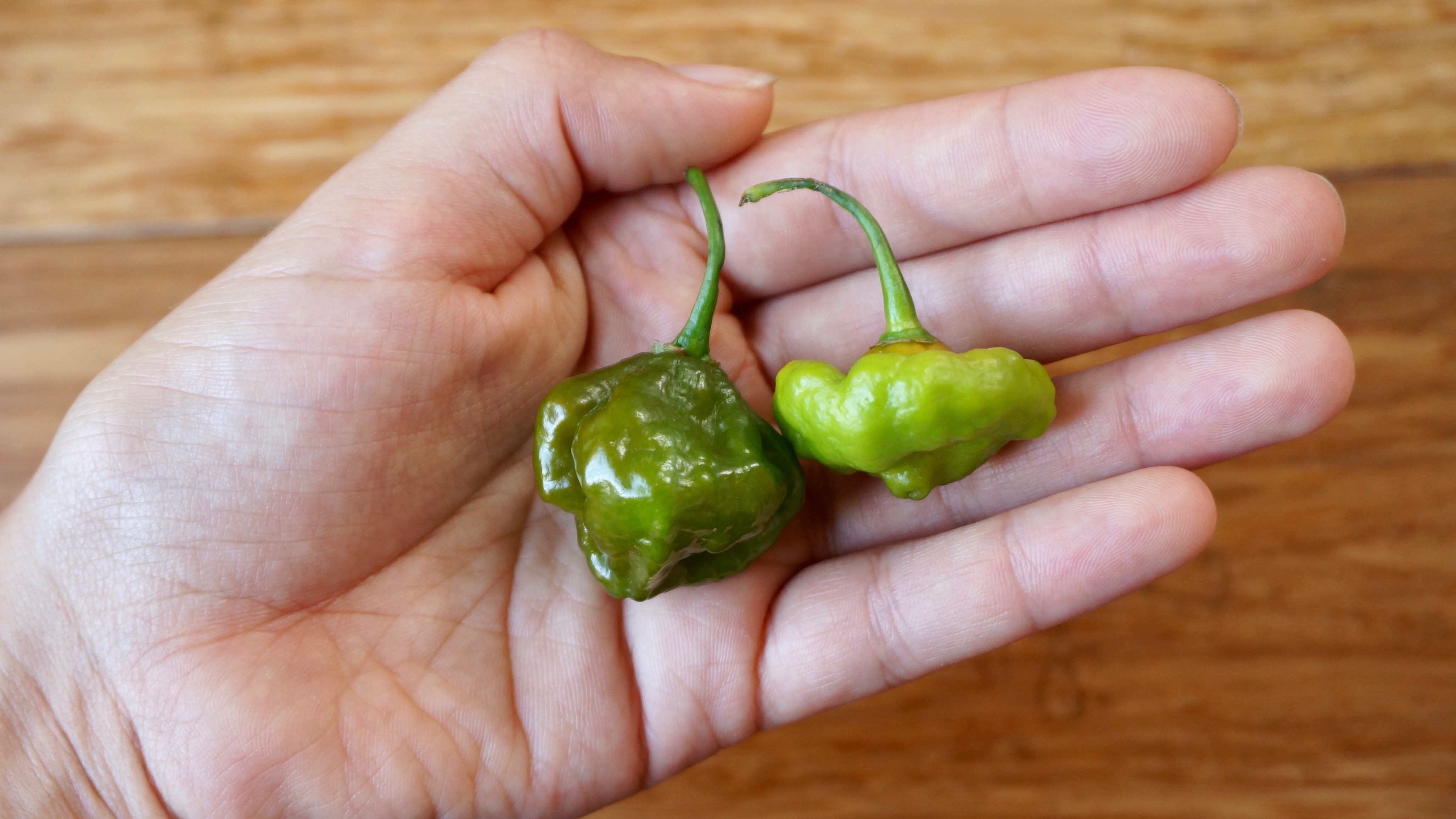
In this photo you can see two ají cachuchas that are different shapes. Both ripened the same color and had the same flavor and heat.
About Capsicum chinense
The Capsicum genus is native to the Americas, and it includes all pepper species from the hot chili peppers to the sweet bell peppers. The Capsicum genus belongs to the family Solanaceae, which is more commonly known as the nightshade family. Tomatoes and eggplants are also in the nightshade family. The C. chinense species includes the hottest chili peppers. It is native to the Brazilian Amazon, where it has been grown for thousands of years. This species of peppers was spread all across the world during the Colombian exchange. Due to this, it is now commonly grown in Asia and Africa.
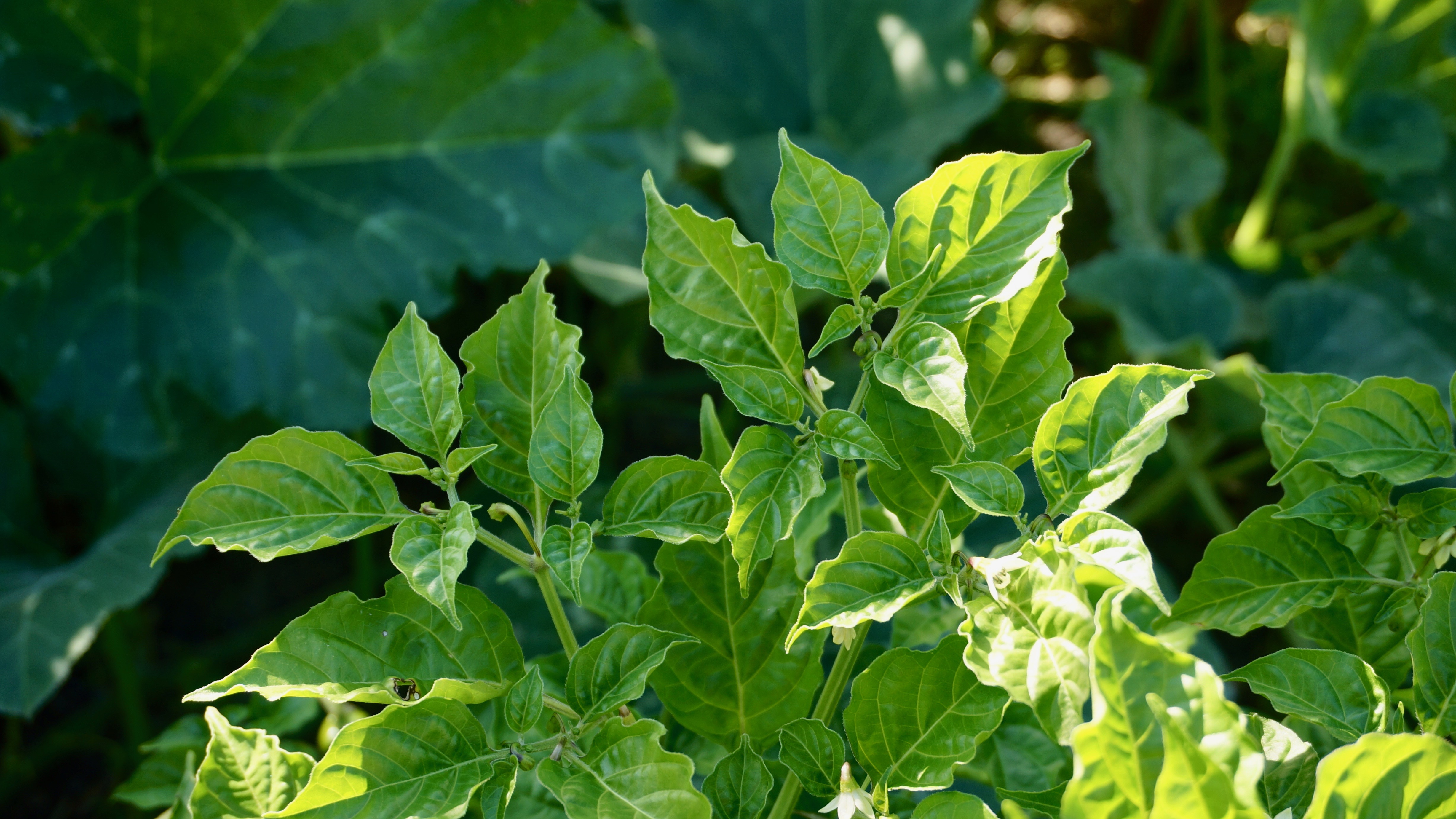
Growth Habit of the Plant
The ají cachucha plant is a shrub that grows as a short-lived perennial in warm climates. In cooler climates it grows as an annual. The plant can reach a height of about 5-6 feet if it is allowed to grow as a perennial. To reach full height the plant can take around a year or two. Over time, the ají cachucha will develop a woody stem at the base while the new growth will be soft and green. The plant has compound leaves and each leaf has 3 leaflets. It also has a shallow root system.
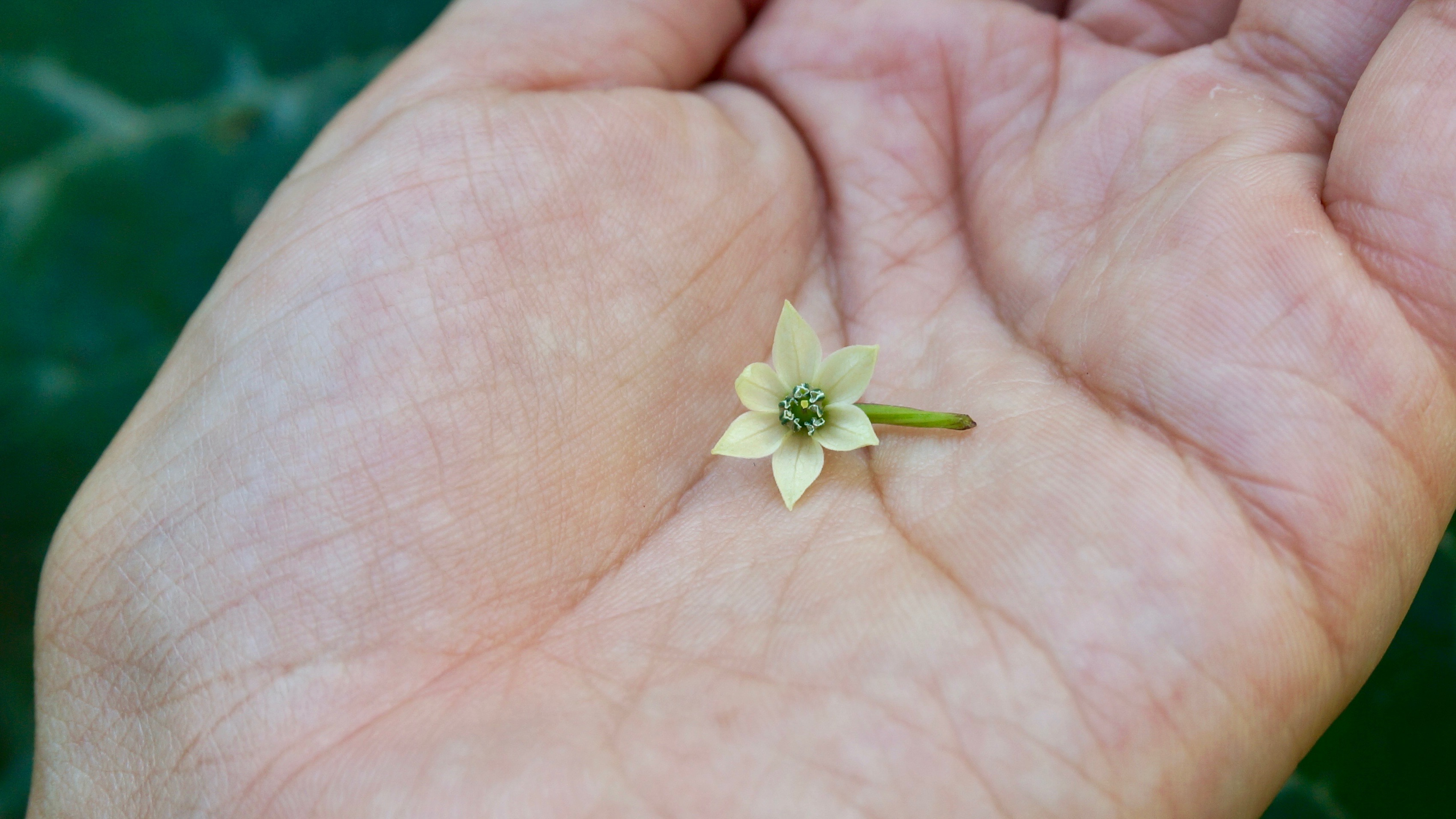
Growth Habit of the Flower
The flowers of the ají cachucha have five petals. The petals are an off-white yellowish color, while the center of the flower is green. The flower can measure about a half-inch across. They are either borne singly or in pairs. My pepper plants flower and fruit all year long in South Florida, and they set the most flowers during the warmer months. Pepper plants produce flowers that are both male and female, which allows them to be self pollinating. This means that only one plant needs to be planted for fruit set. Pollen from a flower can pollinate the same flower or another flower on the same plant. I have gotten a high fruit set on my ají cachucha plants without having to do any hand pollination.
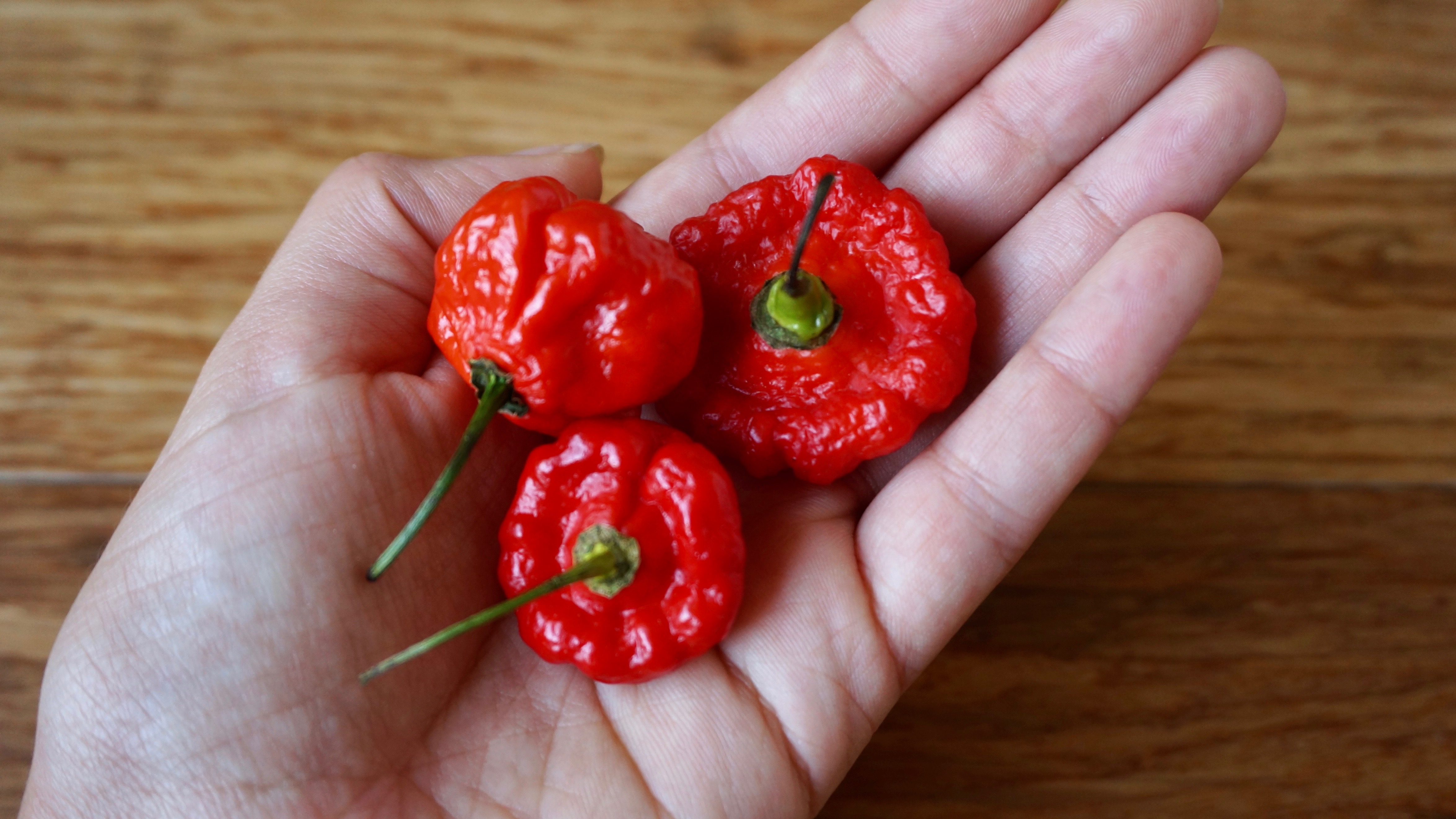
Growth Habit of the Ají Cachucha
The ají cachucha fruit is bright red when fully ripe. There can be many variations in fruit size from plant to plant, but the flavor and color will remain almost the same. The most common shape that is seen in the ají cachucha cultivars is a round flattened disk shape. However, some plants will produce rounder fruit. The disk shaped ají cachuchas can grow 1 to 2 inches in width and 1 inch in height. One ají cachucha can have around 20-30 seeds. The fruits grow relatively quickly and can be picked once fully grown. It is sweet and has no heat compared to a hot chili pepper. It can be said to have a mild hotness if compared to the common sweet bell pepper.
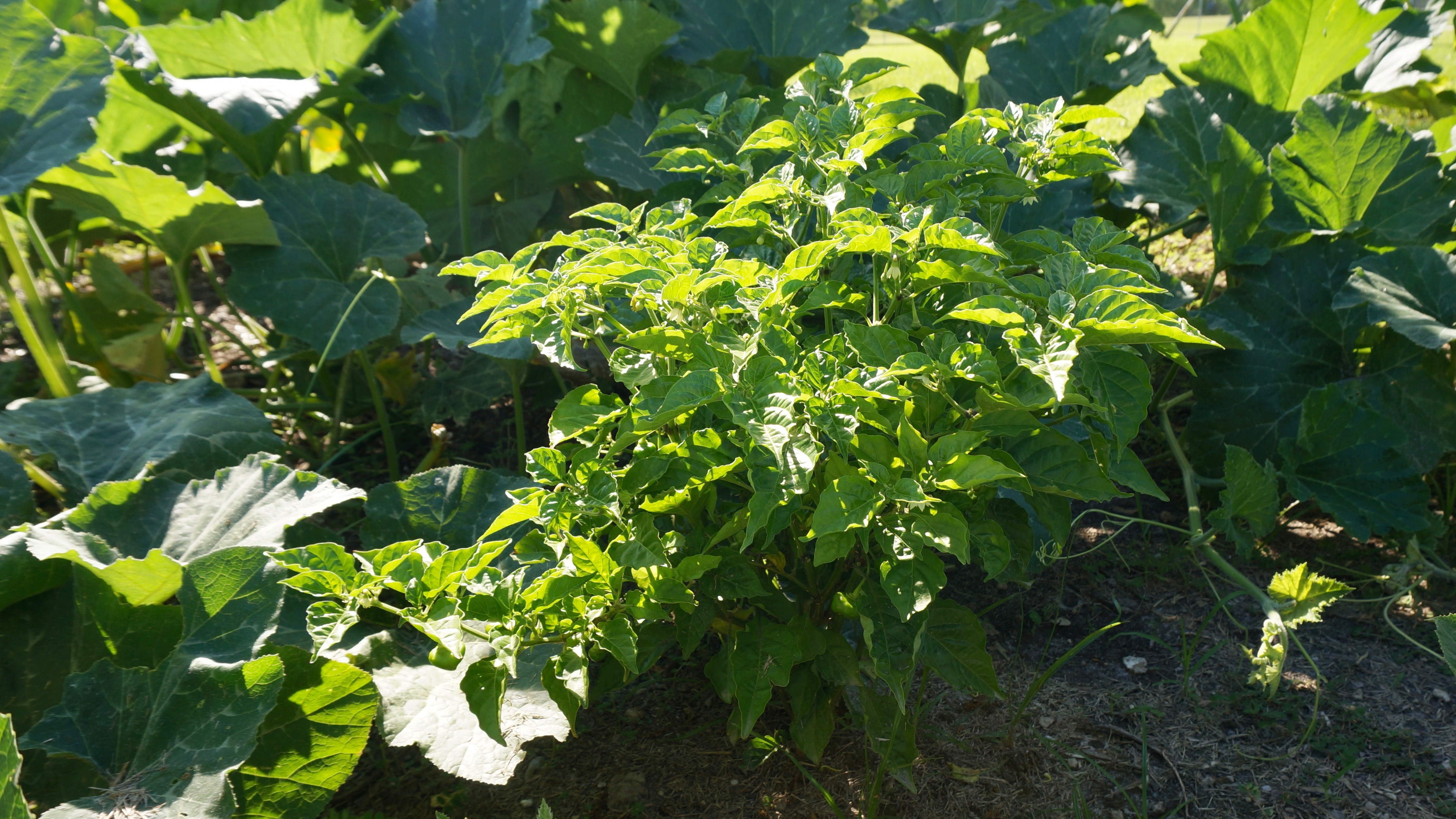
Growing Conditions of the Ají Cachucha
The ají cachucha plant is very vigorous. It does best grown in full sun. If the plant is grown in the shade it will still produce, but the plant will grow very thin and tall. In this situation, supports might be needed to prevent the plant from falling over from the weight of its fruit. In full sun the plants grow more leaves and develop thicker stems. This leads to an overall stronger plant that can better withstand the wind and the weight of its own fruit.
Once established, the plant has low water requirements. All pepper plants do best grown in warm temperatures. The ají cachucha can tolerate cooler temperatures but are very sensitive to frost. If you live in an overall frost free climate this plant can possibly be grown as a perennial with some protection during the winter. If your winters are too cold then you can grow this plant in a pot and bring it indoors during the winter. I have also found that this pepper plant does very well with transplanting. I have pulled up large plants, broken many of its roots, replanted it somewhere else, and have seen them establish themselves well.
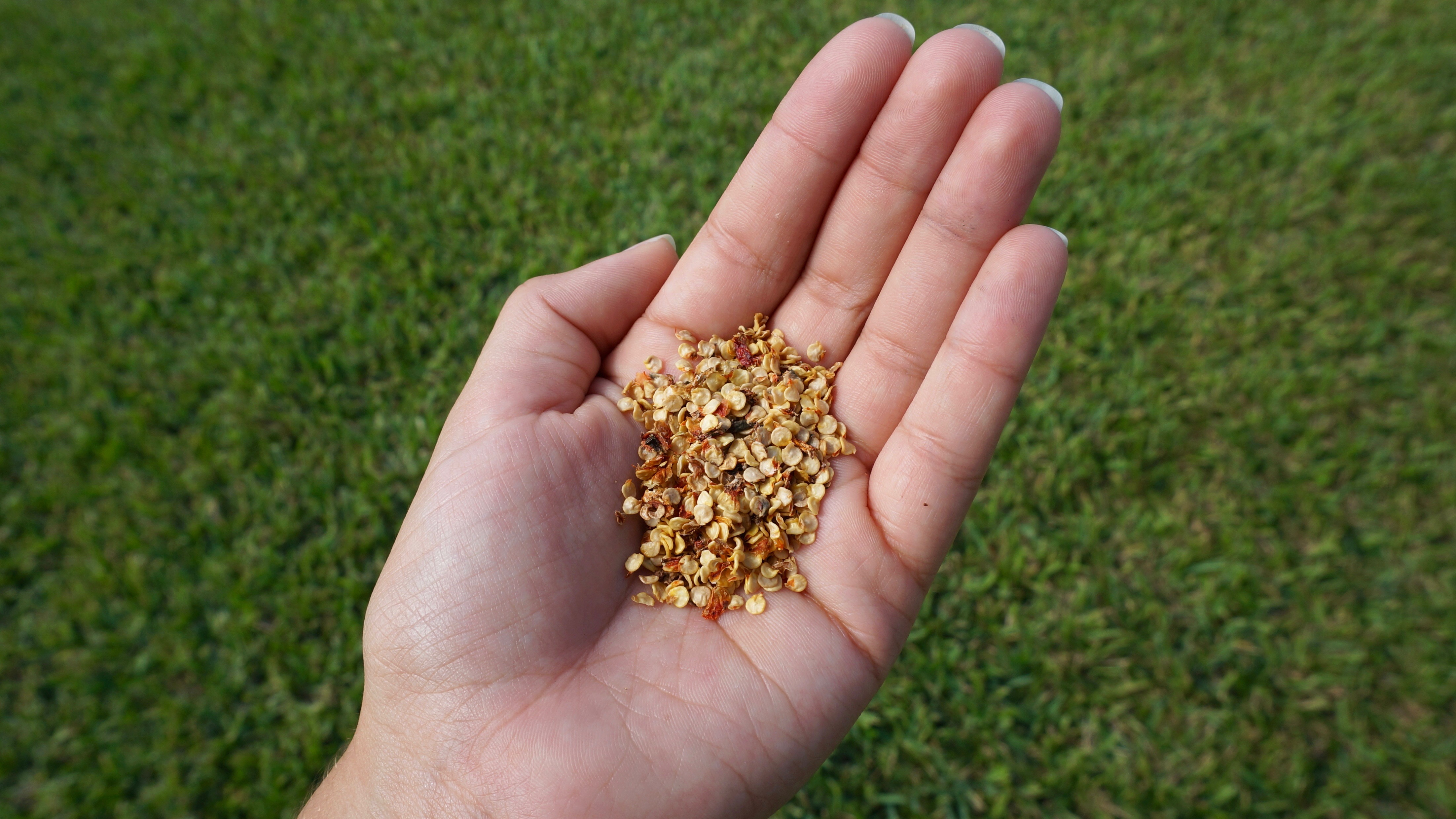
Propagation
The ají cachucha is most easily propagated by seed. Seeds readily germinate and remain viable for years if they are properly stored. A seed grown ají cachucha plant will produce in its first year. It is possible to propagate the ají cachucha by cuttings as well, but I haven’t tried this method. Since they grow so easily from seed, this form of propagation would only be done if you wanted to preserve the genetics of a specific pepper plant.
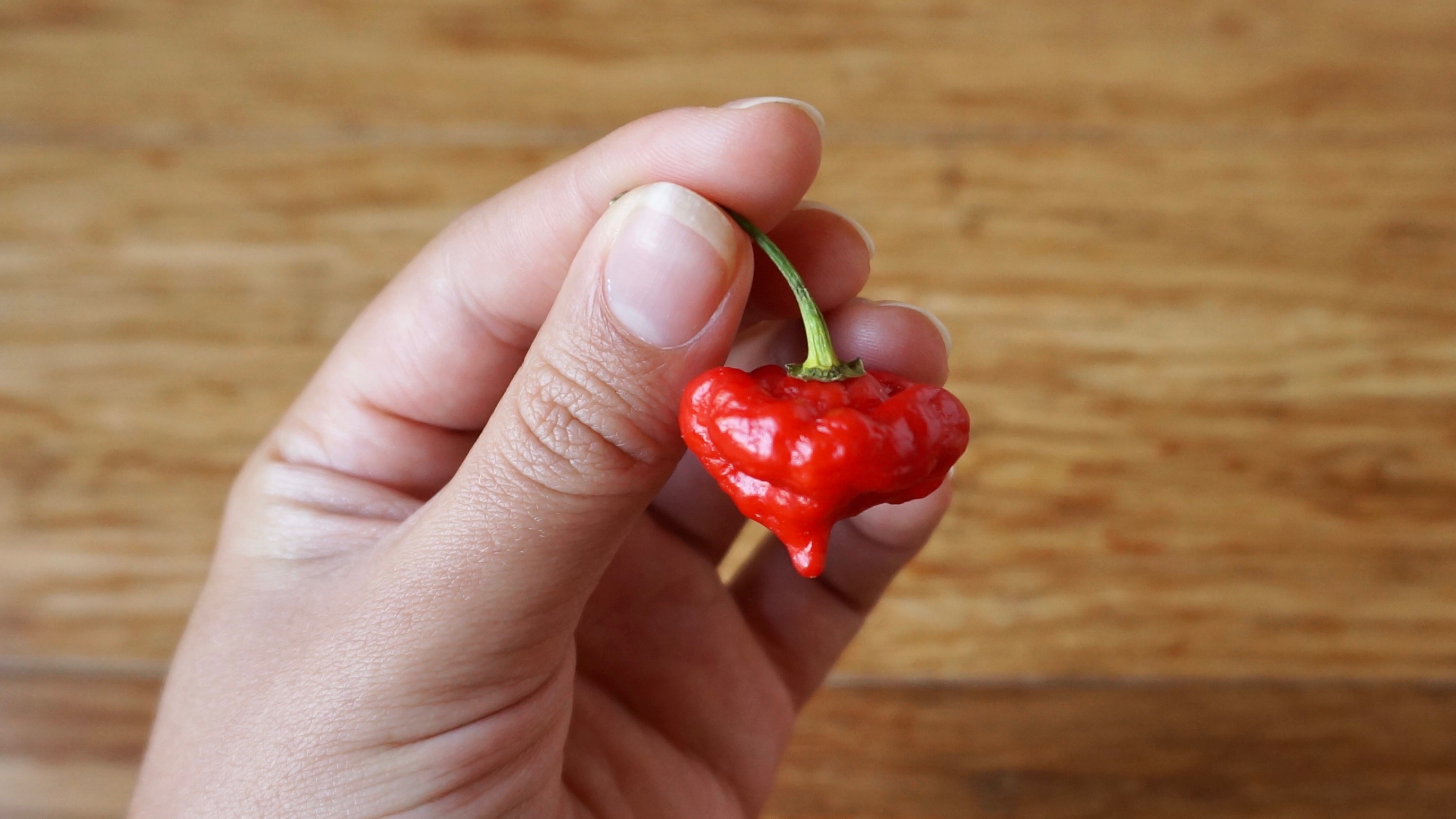
Pests and Diseases
I personally have not experienced any pests or diseases with my multiple ají cachucha plants. However, I have heard of people having difficulty growing the ají cachucha in other parts of South Florida. There is said to be many different bacteria, fungi, and insects that affect peppers. Here is a link that covers some of these.
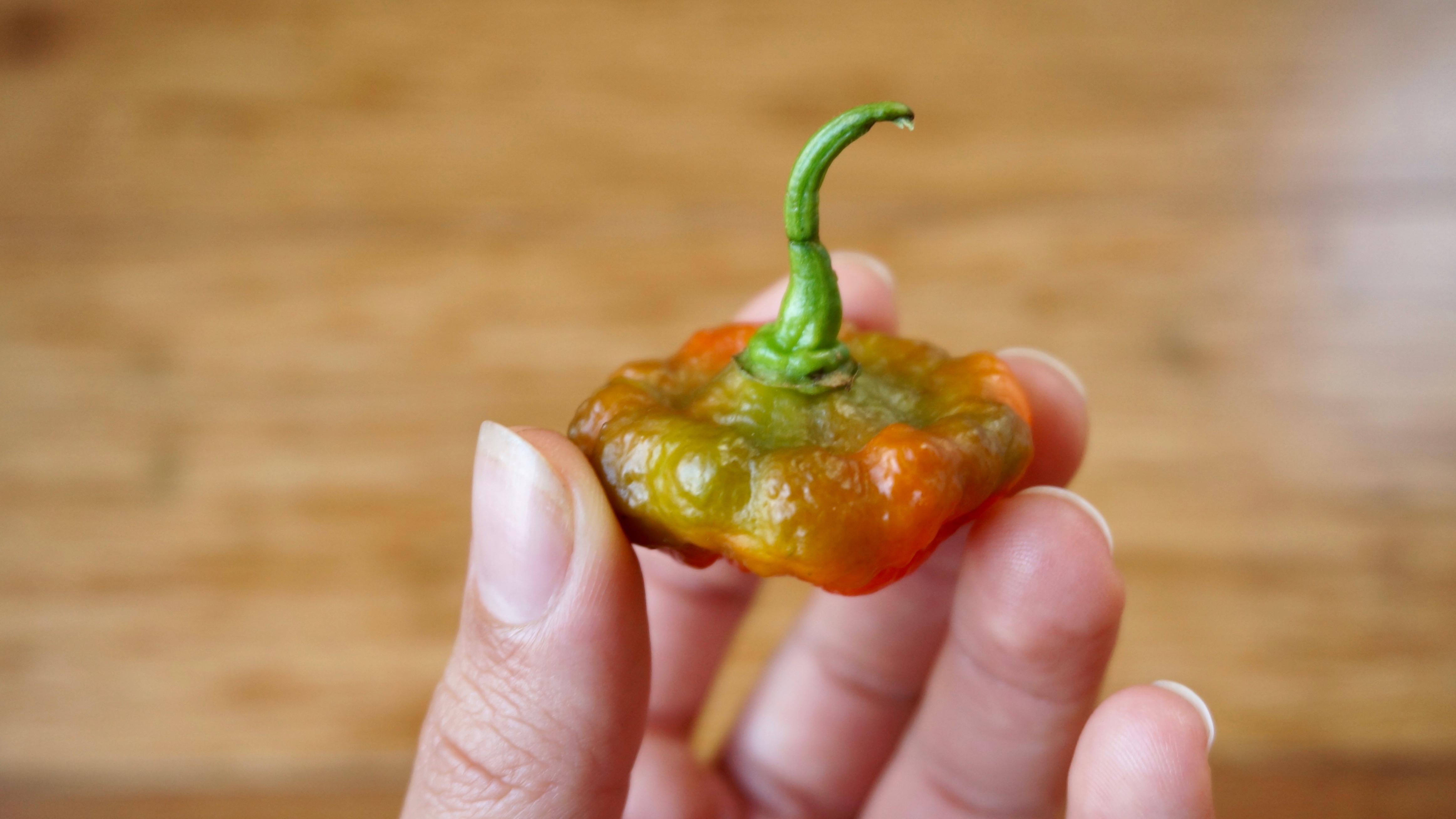
Uses
The ají cachucha can be harvested easily by pinching the stem of the fruit off of the plant. They can be picked while still green, fully red, or somewhere in between. I prefer to pick them once they start turning red. The seeds can be eaten but are normally removed because of their texture. They are frequently used as a seasoning in Cuban, Puerto Rican, and Dominican dishes. During the summer our plants produce a lot, so we add them to almost every dish. I have never used it medicinally, but it is said to have antiseptic properties.
Have you ever seen or eaten any kind of small sweet chili pepper? Have you every grown any yourself? If so, were they the Capsicum chinense species? Let me know down below. You can learn more about other plants by clicking here. Thanks for reading!
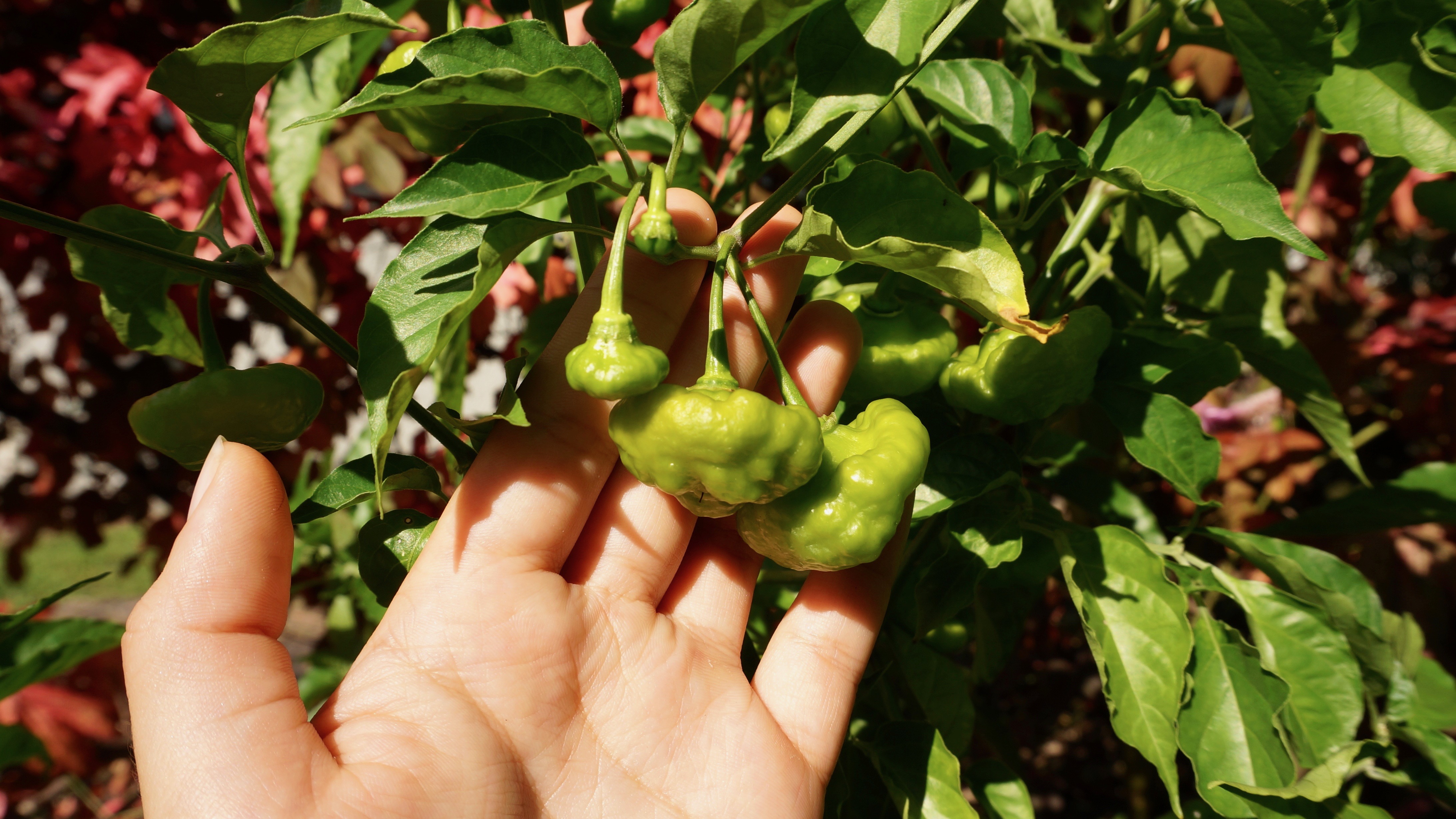
I live on Long Island, NY. I have had an Aji Cachucha plant (harvested from seeds) since 2012 bare in mind we’re now in the year of 2022 & the plant is still alive and bares fruit. I bring my plant inside by November and in May of the next year is put outside but not in full sun, part shade. I love it
I live on Long Island, NY. I have had an Aji Cachucha plant (harvested from seeds) since 2012 bare in mind we’re now in the year of 2022 & the plant is still alive and bares fruit. I bring my plant inside by November and in May of the next year is put outside but not in full sun, part shade. I love this pepper in my black bean soup, garbanzo soup, arroz con pollo.. all of my Cuban Spaniard dishes!! Vale!!
Our plant has produced many, many flowers but they fall off. Is this normal, and when or where will the ajis develop?
If the plants are young it is normal for them to drop some flowers. However, it might have a deficiency if it is larger and is not able to hold onto any of its flowers.
Hello Melanie,
Thank you for this article. I grow several types of peppers every year. I enjoy the hot sauce and the ground up seasoning. This year, my nephew gave me a small Aji Chachucha and it is growing well (about 15 inches tall now). I am worried, however, because it drops the flowers. I have it in a medium size pot outdoors on my patio under a grow lamp. (Not a very hot lamp)
I was wondering if I should move it out in the sun. Here in south Louisiana the sun can be brutal for plants. Do you have any suggestions?
I have about seven or eight varieties of peppers (all in pots). My nephew also gave me a Datil and a Gorbacci. Do you have any advice for those? They are very healthy. The Datil being about 24 inches and the Gorbacci about 12 inches. Neither of them are showing signs of flowering. What do you think. I also worry about over fertilizing.
Thank you very much
The aji cachucha is grown as a perennial in Cuba so it can take the heat and sun. When the plants are young they do drop their flowers and will only hold fruit once bigger. I think taking it outside during earlier hours of the day would be best. Then in the afternoon you can bring it inside since it is hotter then. I do not have any experience growing those other peppers you mentioned.
my ajicito dulce plant was doing well but all of a sudden the leaves are withering and falling off. it looks as if the plant needs water, but when I water still remains the same. any idea what might be happening? i live in Homestead Fl and my plant is outside in a pot in a screen enclosure.
I honestly cannot say for sure. From my experience whenever I see that happening in one of my pepper or eggplant plants it tends to be a root issue. Once I pull the plant up I find the roots are rotted or infested with nematodes.
Hello!
I’ve grown some beautiful ají cach. plants in large pots. I live in the northeast. At what temperature should I bring my pots in and should I trim them down?
That is nice to here that you were able to get some good plants so far north! I can't say for sure what is the lowest temp they can withstand but here in South Florida it rarely gets below 40 degrees Fahrenheit. So I think around 40 degree would be a good temperature to bring them indoors and do your pruning.
My aji dulces are not turning color. They are big and wonderfully green, but not turning color.Any thoughts?
They will turn color when they begin to ripen naturally. You can also eat them green. Many times they are used green for cooking. I don't know of any reason as to why they are not ripening. They probably are just not ready yet is what I think.
I bought seeds from you and so far I have that are about 10”” tall, just transplanted into large pot. I am in SW Fl so they should do good on screen in patio I am hoping. Question do you trim the lower branches as you do we conventional vegetables? And can they take frequent fertilization? Thanks for any advice can’t wait to try them...
That is great to hear your plants are growing! I do trim some of the lower branches to give it better shape. I try to avoid having the branches touching the ground. However, I don't do any heavy pruning like some growers do to their peppers. As for fertilization, I don't do any fertilization on my plants. I just use mulch and then that breaks down and helps the soil over time. Overall the aji dulce is very resilient.
does anyone know where I can buy one in Los Angeles>
Hello, I do not know of any local LA shops that might carry seeds or plants. However, I sell and ship seeds saved from my aji cachucha plants on Etsy. On Etsy I have listed it under the name "aji dulce," but it is the same exact plant that is talked about under this post. Here is the link. https://www.etsy.com/listing/688262745/aji-dulce-seeds-sweet-pepper-capsicum?ref=shop_home_active_1&frs=1&crt=1 . I hope this helped.
I tried your link ans says youre sold out.
Thank you for your interest. I had sold out of the Aji Cachucha seeds for a while but they are now back in stock. If you are still interested then this link will lead you to the Etsy page. https://www.etsy.com/hk-en/listing/688262745/aji-dulce-seeds-sweet-pepper-capsicum
FYI. Ahí cachucha is the secret ingredient for the best BLACK BEANS along with a smudged of brown sugar
I agree! We use them to flavor our black beans along with some Cuban oregano and culantro!
I'm reading this because I just purchased a cachucha plant from my plant guy. And I love the taste of the fruit, so I wanted to do some home work on it.
Awesome! I hope this post helped you and I hope your plant does well!